Topics
Category
Era
Evolution of Dakota Beadwork
Dakota people in what is now Minnesota began using glass beads to decorate clothing, bags, and household items in the mid-nineteenth century. The practice both reinforced and transformed Dakota art, allowing Native artists to preserve a creative tradition that continues in the twenty-first century.
Before European trade introduced glass beads to North America around 1500, Dakota and other Native people made beads from shells, stones, bones, and teeth. Artists used long-bone beads called hairpipe (traditionally made from bison and later from cattle) to adorn clothing like breastplates. They worked beads made from teeth, as well as from shells acquired through trans-continental Native trade networks, into jewelry and dresses.
The designs created in paint, quills, and Native beads carried over into beadwork made after European contact. The Dakota began to use hand-blown beads, then standardized “pony” beads, and finally smaller, factory-made “seed” beads. They turned to seed beads in particular to experiment with new techniques while maintaining and reproducing older styles.
Beadwork, like quillwork before it, was the traditional domain of Native women. By the early nineteenth century, Dakota women were exchanging food, skins, and pelts with Euro-American traders in return for goods like cloth, silk ribbons, and glass beads. They ordered specific colors, sizes, and cuts on sample cards—small pieces of cardstock decorated with different manufacturers’ beads.
By the 1830s, Dakota women had access to commercial glass beads in a variety of colors, sizes, and shapes. The new material posed new challenges, like using glass to mimic the subtle color gradations of dyed quills and beading the yoke of a dress without making it too heavy for its wearer. Over time, glass beads replaced both quills and handmade beads on Dakota objects because of their variety, convenience, and availability. By 1850, Dakota designs featured contrasting stripes; bilateral symmetry; and freestanding elements like stars, leaves, and flowers against bead-free backgrounds.
Even when they used new designs and materials, Dakota artists fashioned objects that reflected Indigenous worldviews and made sense on Indigenous terms. Objects made from imported materials retained both Dakota aesthetics and Dakota uses. In this period, for instance, men’s formal shirts were often made with heavy cotton instead of brain-tanned deerskin; decorated with glass beads instead of porcupine quills; and cut in the style of Western waistcoats instead of traditional war-honors shirts. But they continued to highlight Dakota forms and carry forward the tradition of bestowing men with vests that essentially wrapped them in Dakota-ness.
With the importation of Euro-American goods into Dakota life came an influx of Euro-Americans themselves. Over a few decades, white colonists displaced the Dakota within their homelands. The situation escalated in the summer of 1862 during the US–Dakota War. At the end of the war, the U.S. government forcibly transported most surviving Dakota to prison camps within Minnesota and Iowa and then permanently expelled them from both states. Most of the Dakota were forced west to live in Nebraska and Dakota Territory, closer to their Lakota kin; some remained in small communities in Minnesota.
Almost no Dakota artwork survives from the decade after the U.S.–Dakota War. Many people barely survived. In unfamiliar places, often lacking food, shelter, and medicine, staying alive from season to season took precedent over making art. By about 1875, however, Dakota artists had renewed the beadwork tradition, with a noticeable change. While some continued to use traditional motifs, others started to reinterpret the distinctly Lakota patterns of their new neighbors.
Without abandoning the delicate, bilaterally symmetrical, standalone pastel florals of pre-war Dakota work, Dakota women began to incorporate the geometry, bold colors, and repeated shapes of Lakota objects. They also beaded objects more heavily, in the style of Lakota pieces.
By 1890, after the establishment of the reservation system and the end of the treaty-making era, traditional Native economies had largely collapsed. The U.S. government told the Dakota and other Native groups to abandon their old lifeways, assimilate into Euro-American culture, and live on single-family farms.
The stark economic changes Dakota people endured are reflected in the artwork produced during the late nineteenth and early twentieth centuries. Increasingly, Dakota artists created beaded items not for tribal use but for sale to Euro-Americans. They produced miniature versions of utilitarian objects like tipis, clubs, and snowshoes as well as figures of Dakota people themselves—primarily because they were easy to transport.
To appeal to tourists, they applied European motifs, such as representations of animals and people, to Euro-American items like fitted jackets and vests. European decorative items such as pincushions, fobs, and wall pockets became popular. Dakota artists fixed beads to items like bottles and doctors’ valises that had never been beaded before. They began to decorate objects with non-Native symbols, including American flags and Christian crosses.
Ever adaptive, Dakota art and culture persisted in the midst of continued pressure on the Dakota to assimilate at the turn of the twentieth century. During the 1920s, Dakota people created cottage industries to sell handmade goods and curios to tourists without abandoning the old ways. Many of the objects made during this time are a mix of European and Native styles. The Arts and Crafts movement, which thrived between 1880 and 1920, drew from the designs of Dakota bags and other decorative items.
Art historians are able to attribute specific objects to individual artists—rather than to tribal or regional groups—starting in the 1920s and 1930s. For example, Rebecca Bluecloud, a Dakota woman from the Upper Sioux reservation in Granite Falls, supported her family during hard times by involving them in the manufacture of beaded items, particularly dolls.
To further break down communities and assimilate Native people into American culture, the U.S. government introduced a policy of relocation in 1956. Designed to lure Native workers away from their reservation homes and into cities like Chicago, Denver, and Los Angeles, this policy split the Native American population of the United States between reservation residents and urban dwellers. It also had the unintended effect of strengthening Native identity—and art traditions—through pan-Indian unity.
In the mid-twentieth century, Dakota artwork shifted again. The survival of Dakota beadwork practices was itself a symbol of Indigenous resistance to assimilation. Partly inspired by the successes of the Black Power movement, a burgeoning Native rights movement was born. Its most organized form was the American Indian Movement (AIM), established in Minneapolis in 1968. The exchange of Native cultural traditions within American cities resulted in a mixing of styles in Native beadwork in general, and in Dakota beadwork in particular. Much of the Dakota beadwork from this period emulated Lakota and Western Plains styles.
In the twenty-first century, many Dakota artists are reclaiming their culture by studying old techniques, including beadwork. Contemporary Dakota artists like Holly Young, for example, are reviving the bilateral symmetry and florals of pre-1862 beaded objects. Others, like Dallas Goldtooth and Gwen Westerman, are reviving quillworking and ribbonworking. Still others, like Bobby Wilson, are translating the old styles into modern media. Different stages in the development of Dakota beadwork find representation in pow-wow regalia pieces like breastplates, shawls, belts, shoes, and jewelry.
Bibliography
Aho, Melissa K. “Bead Colors in the Upper Mississippi Valley and the American Fur Company.” Master’s thesis, University of Wisconsin, 1998.
Anderson, Marcia G., and Herb Dorr. “The Bluecloud Dolls of Granite Falls: A Dakota Story.” American Indian Art 40, no. 4 (Fall 2015): 42–47.
Digital Public Library of America. History of Survivance: Upper Midwest 19th-Century Native American Narratives.
http://dp.la/exhibitions/exhibits/show/history-of-survivance
Dubin, Lois Sherr. The History of Beads: 100,000 BC to the Present. New York: Harry N. Abrams, 1987.
Emil Her Many Horses, ed. Tradition, Change, and Celebration in Native Women’s Dresses. Washington, D.C.: National Museum of the American Indian, 2007.
Fergus, Rachel. "Look at Art, History Through a Dakota Lens." Rochester Post-Bulletin, May 16, 2020.
https://www.postbulletin.com/entertainment/art/6494434-Look-at-art-history-through-a-Dakota-lens
Hyman, Colette A. Dakota Women’s Work: Creativity, Culture, and Exile. St. Paul: Minnesota Historical Society Press, 2012.
McClure, Nancy. “The Art of Beadwork: An Old But New Tradition.” Points West (Summer 2004).
http://centerofthewest.org/2014/12/28/points-west-online-art-beadwork
Minnesota Historical Society. Oceti Sakowin: The Seven Council Fires.
http://collections.mnhs.org/sevencouncilfires
Thao, Susan. Worn Within: What Is The Difference Between Dakota and Ojibwe Beadwork? Twin Cities PBS Originals.
https://www.tptoriginals.org/worn-within-what-is-the-difference-between-dakota-ojibwe-beadwork
Related Resources
Secondary
Clemmons, Linda M. Conflicted Mission: Faith, Disputes, and Deception on the Dakota Frontier. St. Paul: Minnesota Historical Society Press, 2014.
Lomawaima, K. Tsianina, and Margaret Archuleta, eds. Away From Home: American Indian Boarding School Experiences, 1879–2000. Phoenix: Heard Museum, 2000.
Westerman, Gwen, and Bruce White. Mni Sota Makoce: The Land of the Dakota. St. Paul: Minnesota Historical Society Press, 2012.
Web
Minnesota Historical Society. Native American Artist-In-Residence Program.
http://www.mnhs.org/residencies
National Museum of the American Indian Education Office. A Life in Beads: The Stories a Plains Dress Can Tell.
http://nmai.si.edu/sites/1/files/pdf/education/NMAI_lifeinbeads.pdf
Related Video
Dakota beadwork artist Holly Young
Beadwork artist Holly Young shares her experiences as a Native American Artist-in-Residence (NAAIR) at the Minnesota Historical Society. NAAIR artists study collections items to better understand their respective art forms and then share their knowledge with the community.
More Information
Articles
Related Images
Double string of beads includes glass, clay and agate beads; the strand is divided into four rings that are separated by a flat white bead with double holes. The beads are mostly amber colored with a few faceted, round, or cylindrical beads. Additional colors range from plain blue, yellow, or green to multicolored figured beads. The beads were restrung in 1962, but the original bead order has since been restored.
A Dakota beaded and quilled leather storage or "possibles" bag. The bag is rectangular in shape, with porcupine-quilled red lines on the front and beaded geometrics on the sides, and is decorated with tufts of yellow and purple horsehair emerging from metal cones. Made by Nancy McClure Faribault, wife of David Faribault, circa 1880.
A Dakota, possibly Yankton, beaded knife sheath dating to the last quarter of the nineteenth century. Two beaded tassels are attached to the sheath's bottom; one tassel ends in metal cones. A string ending in metal cones connects the sheath's sides on either side of its opening. The reverse side of the sheath is undecorated save for a few rows of blue beads near the opening.
A pair of beaded Dakota-Metis half leggings, probably from the Red River region of North Dakota, Minnesota, and Manitoba, made in the mid 1800s. The leggings are beaded on their front faces with a series of standalone fantasy floral and double-curved motifs typical of Dakota-Metis (as well as Santee Dakota and some Crow) beadwork decoration. Each legging is bordered in a beaded checkerboard motif.
Fringed and beaded Dakota bag with drawstring closure created in the 1930s for sale to tourists. The five left-facing swastikas rendered in beads are traditional American Indian (as well as Southeast Asian) symbols of peace and good fortune. Their use in this context pre-dates, and is unconnected to, Nazism.
A cradleboard made by Hope Two Hearts and Galen Drapeau (Isanti and Ihanktonwan Dakota, respectively), c.1980. The cradleboard, which won best traditional art at the Sante Fe Indian Market Show, was originally made for Hanhepi Maniwin. An image of her in this cradleboard was featured in promotional materials for Hope and Galen's business, the Elk's Camp Society.
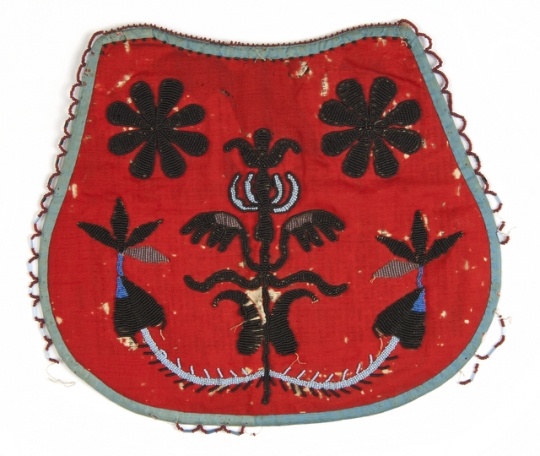
Dakota beaded bag
Beaded bag made by Margeurite Metivier (Dakota), ca.1860.
All rights reserved
Holding Location
More Information

Bone trade beads
Hair-pipe bone beads used in the fur trade no earlier than 1700 and no later than 1837.
All rights reserved
Holding Location
More Information
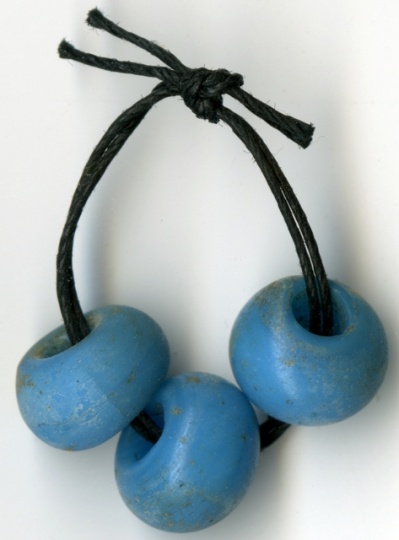
Light blue glass trade beads
Three opaque light blue pony beads made between 1700 and 1837.
All rights reserved
Holding Location
Articles
More Information

Dakota glass, clay, and agate beads
Double string of beads includes glass, clay and agate beads; the strand is divided into four rings that are separated by a flat white bead with double holes. The beads are mostly amber colored with a few faceted, round, or cylindrical beads. Additional colors range from plain blue, yellow, or green to multicolored figured beads. The beads were restrung in 1962, but the original bead order has since been restored.
All rights reserved
Holding Location
Articles
More Information
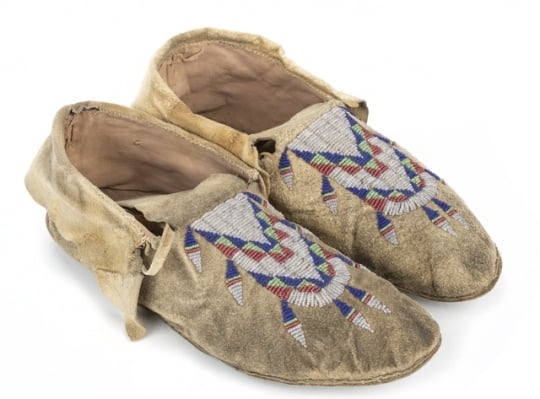
Dakota beaded moccasins
Leather moccasins beaded with a geometric design. Originally owned by John Other Day (Wahpeton Dakota) and given to Stephen Return Riggs, a missionary and government interpreter among the Dakota in southwestern Minnesota, ca. 1860.
All rights reserved
Holding Location
Articles
More Information

Dakota beadwork band
Dakota band with loomed, geometric beadwork, c.1890.
All rights reserved
Holding Location
Articles
More Information
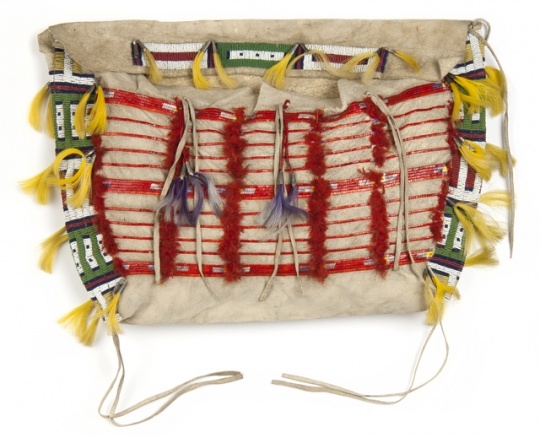
Dakota beaded leather bag
A Dakota beaded and quilled leather storage or "possibles" bag. The bag is rectangular in shape, with porcupine-quilled red lines on the front and beaded geometrics on the sides, and is decorated with tufts of yellow and purple horsehair emerging from metal cones. Made by Nancy McClure Faribault, wife of David Faribault, circa 1880.
All rights reserved
Holding Location
Articles
More Information
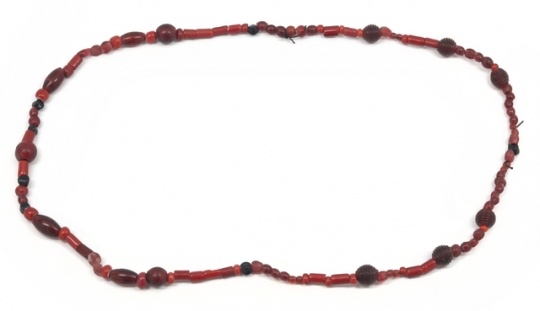
Dakota beaded glass necklace
Dakota necklace made from a string of light pink amber glass beads of various sizes and shapes. The beads are European glass of the type used in the fur trade, are worn, and have been restrung on a nylon cord. Made ca. 1890.
All rights reserved
Holding Location
Articles
More Information
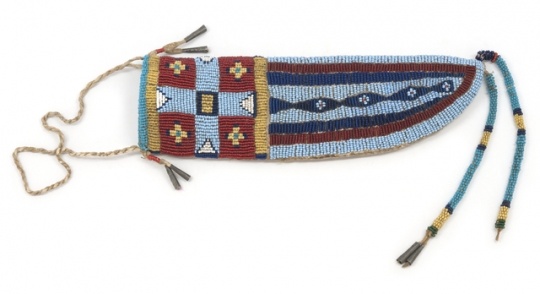
Dakota beaded knife sheath
A Dakota, possibly Yankton, beaded knife sheath dating to the last quarter of the nineteenth century. Two beaded tassels are attached to the sheath's bottom; one tassel ends in metal cones. A string ending in metal cones connects the sheath's sides on either side of its opening. The reverse side of the sheath is undecorated save for a few rows of blue beads near the opening.
All rights reserved
Holding Location
Articles
More Information
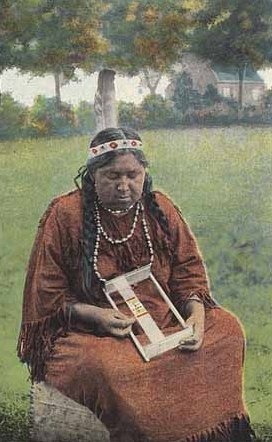
Dakota woman making beadwork
Colorized picture postcard featuring a Dakota woman making beadwork, c.1930.
Holding Location
Articles
More Information
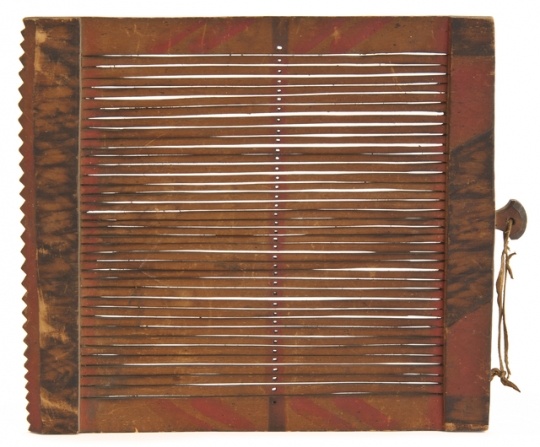
Dakota wood loom frame
A Dakota loom frame or heddle with wooden bars, early-to-mid 1800s.
All rights reserved
Holding Location
Articles
More Information
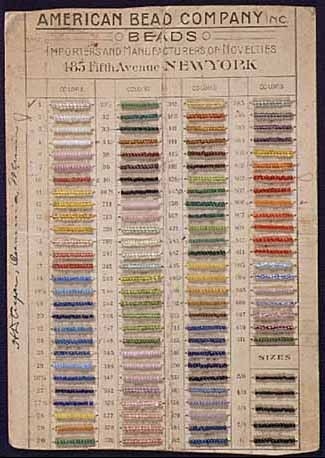
Sample card of glass seed beads
Sample card of glass seed beads sold at the Mille Lacs Indian Museum and Trading Post in Onamia between 1920 and 1959.
All rights reserved
Holding Location
Articles
More Information
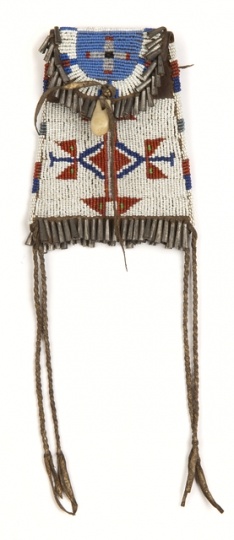
Dakota beaded leather pouch
Dakota leather pouch with lane-stitched geometric beadwork made in the 1800s.
All rights reserved
Holding Location
Articles
More Information
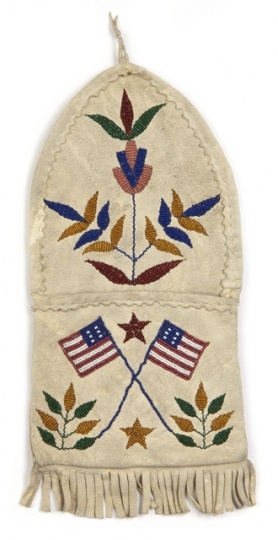
Dakota beaded wall pocket
Beaded wall pocket made by Dakota Indians. Collected at the Cheyenne River Indian Reservation in the late nineteenth or early twentieth century.
All rights reserved
Holding Location
Articles
More Information
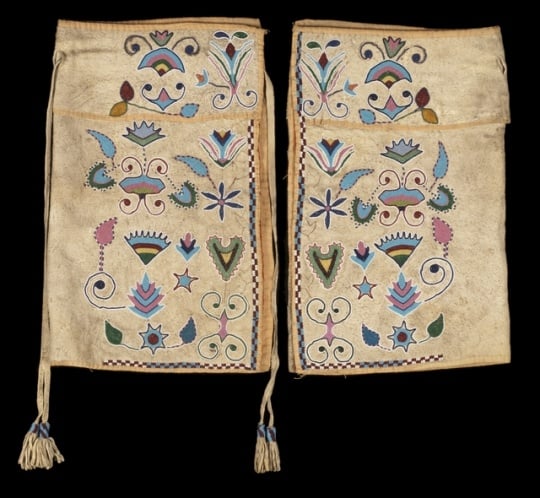
Half leggings
A pair of beaded Dakota-Metis half leggings, probably from the Red River region of North Dakota, Minnesota, and Manitoba, made in the mid 1800s. The leggings are beaded on their front faces with a series of standalone fantasy floral and double-curved motifs typical of Dakota-Metis (as well as Santee Dakota and some Crow) beadwork decoration. Each legging is bordered in a beaded checkerboard motif.
All rights reserved
Holding Location
More Information

Dakota beaded scissors case
Beaded Dakota case, c.1900. From the Cheyenne Indian Reservation; probably made as a tourist souvenir.
All rights reserved
Holding Location
Articles
More Information
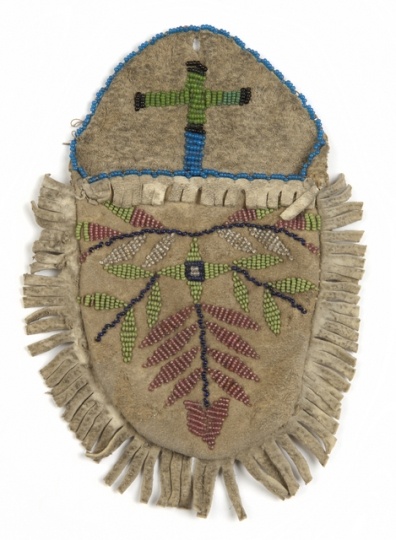
Dakota wall pocket
Dakota beaded wall pocket made c.1900.
All rights reserved
Holding Location
Articles
More Information
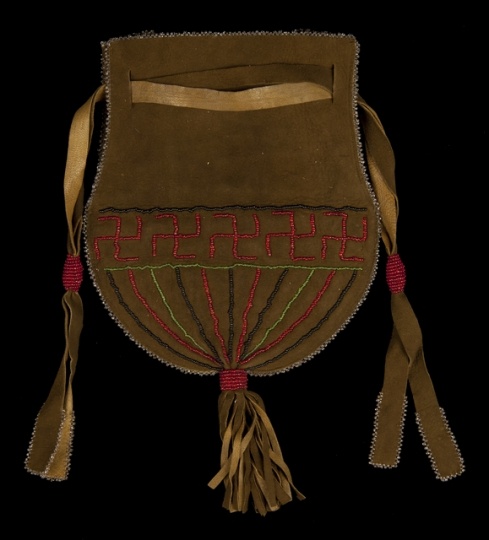
Fringed and beaded Dakota bag
Fringed and beaded Dakota bag with drawstring closure created in the 1930s for sale to tourists. The five left-facing swastikas rendered in beads are traditional American Indian (as well as Southeast Asian) symbols of peace and good fortune. Their use in this context pre-dates, and is unconnected to, Nazism.
All rights reserved
Holding Location
Articles
More Information
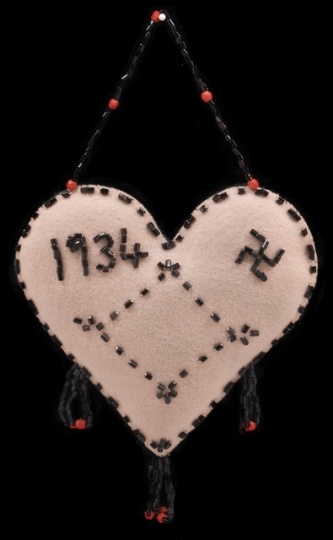
Beaded pincushion
A beaded pincushion from the Dakota community at Prairie Island in Goodhue County, c.1930s. The left-facing swastika included on the cushion is a traditional Native American (as well as Southeast Asian) symbol of peace and good fortune. Its use in Native art pre-dates and is unrelated to Nazism.
All rights reserved
Holding Location
Articles
More Information
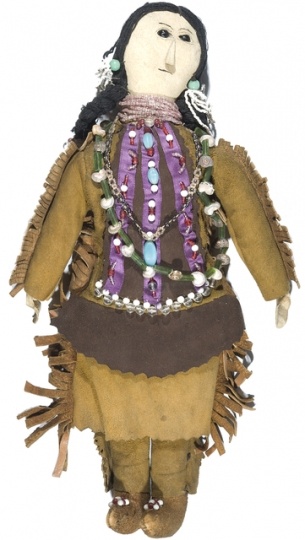
Beaded doll
A doll probably made by Rebecca Bluecloud, an artist from the Upper Sioux Indian Community in Granite Falls, in the 1920s or 1930s.
All rights reserved
Holding Location
Articles
More Information
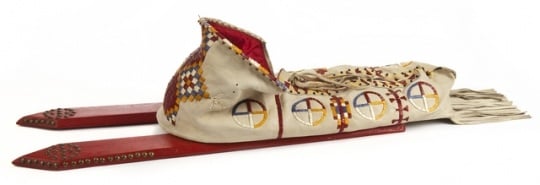
Quilled and beaded cradleboard
A cradleboard made by Hope Two Hearts and Galen Drapeau (Isanti and Ihanktonwan Dakota, respectively), c.1980. The cradleboard, which won best traditional art at the Sante Fe Indian Market Show, was originally made for Hanhepi Maniwin. An image of her in this cradleboard was featured in promotional materials for Hope and Galen's business, the Elk's Camp Society.
All rights reserved
Holding Location
Articles
More Information
Related Articles
Turning Point
In the early 1830s, European traders introduce glass beads to the present-day Midwestern United States. Dakota artists incorporate the new material into traditional artwork and household objects.
Chronology
c.1500
Late 1600s
c.1830
1840s–1860s
c.1850
1862–1875
c.1900
1920s
1930s
1956
1968
c.2000s
Bibliography
Aho, Melissa K. “Bead Colors in the Upper Mississippi Valley and the American Fur Company.” Master’s thesis, University of Wisconsin, 1998.
Anderson, Marcia G., and Herb Dorr. “The Bluecloud Dolls of Granite Falls: A Dakota Story.” American Indian Art 40, no. 4 (Fall 2015): 42–47.
Digital Public Library of America. History of Survivance: Upper Midwest 19th-Century Native American Narratives.
http://dp.la/exhibitions/exhibits/show/history-of-survivance
Dubin, Lois Sherr. The History of Beads: 100,000 BC to the Present. New York: Harry N. Abrams, 1987.
Emil Her Many Horses, ed. Tradition, Change, and Celebration in Native Women’s Dresses. Washington, D.C.: National Museum of the American Indian, 2007.
Fergus, Rachel. "Look at Art, History Through a Dakota Lens." Rochester Post-Bulletin, May 16, 2020.
https://www.postbulletin.com/entertainment/art/6494434-Look-at-art-history-through-a-Dakota-lens
Hyman, Colette A. Dakota Women’s Work: Creativity, Culture, and Exile. St. Paul: Minnesota Historical Society Press, 2012.
McClure, Nancy. “The Art of Beadwork: An Old But New Tradition.” Points West (Summer 2004).
http://centerofthewest.org/2014/12/28/points-west-online-art-beadwork
Minnesota Historical Society. Oceti Sakowin: The Seven Council Fires.
http://collections.mnhs.org/sevencouncilfires
Thao, Susan. Worn Within: What Is The Difference Between Dakota and Ojibwe Beadwork? Twin Cities PBS Originals.
https://www.tptoriginals.org/worn-within-what-is-the-difference-between-dakota-ojibwe-beadwork
Related Resources
Secondary
Clemmons, Linda M. Conflicted Mission: Faith, Disputes, and Deception on the Dakota Frontier. St. Paul: Minnesota Historical Society Press, 2014.
Lomawaima, K. Tsianina, and Margaret Archuleta, eds. Away From Home: American Indian Boarding School Experiences, 1879–2000. Phoenix: Heard Museum, 2000.
Westerman, Gwen, and Bruce White. Mni Sota Makoce: The Land of the Dakota. St. Paul: Minnesota Historical Society Press, 2012.
Web
Minnesota Historical Society. Native American Artist-In-Residence Program.
http://www.mnhs.org/residencies
National Museum of the American Indian Education Office. A Life in Beads: The Stories a Plains Dress Can Tell.
http://nmai.si.edu/sites/1/files/pdf/education/NMAI_lifeinbeads.pdf























